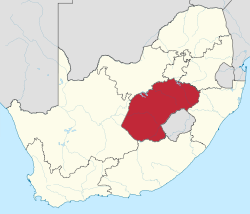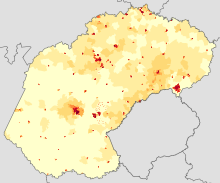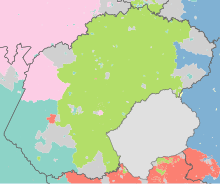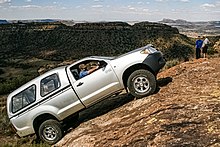Free State (province)
This article includes alist of references,related reading,orexternal links,but its sources remain unclear because it lacksinline citations.(December 2023) |
Free State
| |
|---|---|
| Motto(s): Katleho ka kopano (Success through unity) | |
 Location of the Free State in South Africa | |
| Coordinates:28°S27°E/ 28°S 27°E | |
| Country | South Africa |
| Orange Free State | 17 February 1854 |
| OFS Province | 31 May 1910 |
| Free State | 27 April 1994 |
| Capital | Bloemfontein |
| Districts | |
| Government | |
| • Type | Parliamentary system |
| •Premier | Maqueen Letsoha-Mathae(ANC) |
| • Legislature | Free State Provincial Legislature |
| Area [1]: 9 | |
| • Total | 129,825 km2(50,126 sq mi) |
| • Rank | 3rd in South Africa |
| Highest elevation | 3,291 m (10,797 ft) |
| Population (2022)[3] | |
| • Total | 2,961,864 |
| • Rank | 8th in South Africa |
| • Density | 23/km2(59/sq mi) |
| • Rank | 8th in South Africa |
| Population groups (2022) | |
| •Black | 88.9% |
| •White | 8.0% |
| •Coloured | 2.6% |
| •IndianorAsian | 0.4% |
| • Other | 0.1% |
| Languages (2022) | |
| •Sotho | 72.3% |
| •Afrikaans | 10.3% |
| •Xhosa | 5.5% |
| •Tswana | 5.3% |
| •English | 1.5% |
| Time zone | UTC+2(SAST) |
| ISO 3166 code | ZA-FS |
| GDP | US$20.0 billion[4] |
| HDI(2019) | 0.708[5] high·4th of 9 |
| Website | www |
| Zulu | iFuleyisitata |
|---|---|
| Xhosa | iFreyistata |
| Afrikaans | Vrystaat |
| Sesotho | Freistata |
| Setswana | Foreistata |
TheFree State(Sotho:Freistata;Afrikaans:Vrystaat[ˈfrɛistɑːt];Xhosa:iFreyistata;Tswana:Foreistata;Zulu:iFuleyisitata), formerly known as theOrange Free State,is aprovince of South Africa.Its capital isBloemfontein,which is alsoSouth Africa's judicial capital. Its historical origins lie in theBoer republiccalled theOrange Free Stateand later theOrange Free State Province.
History
[edit]The current borders of the province date from 1994 when theBantustanswere abolished and reincorporated into South Africa. It is also the only one of the four original provinces of South Africa not to undergo border changes, apart from the reincorporation of Bantustans, and its borders date from before the outbreak of theBoer War.
Geography
[edit]
The Free State is situated on a succession of flat grassy plains sprinkled with pastureland, resting on a general elevation of 3,800 feet only broken by the occasional hill orkopje.The rich soil and pleasant climate allow for a thriving agricultural industry.
The province is high-lying, with almost all land being 1,000 metres above sea level. TheDrakensbergandMaloti Mountainsfoothills raise the terrain to over 2,000 m in the east. The Free State lies in the heart of theKarooSequence of rocks, containingshales,mudstones,sandstonesand the DrakensbergBasaltforming the youngest capping rocks. Mineral deposits are plentiful, with gold anddiamondsbeing of particular importance, mostly found in the north and west of the province.
Fauna and flora
[edit]The flats in the south of the reserve provide ideal conditions for large herds of plain game such asblack wildebeestandspringbok.The ridges, koppies and plains typical of the northern section are home tokudu,red hartebeest,southern white rhinocerosandbuffalo.TheSouthern African wildcat,black wildebeest,zebra,eland,white rhinoceros andwild dogcan be seen at theSoetdoring Nature ReservenearBloemfontein.TheSouth African cheetahswere reintroduced in the Free State for the first time in June 2013 after a hundred years of regional extinction, atLaohu Valley ReservenearPhilippolis.[6]Following the reintroduction of an adult female South African cheetah in early 2016, three wild cheetah cubs were born for the first time in Laohu Valley Reserve in February 2017, making the three new cubs the first cheetahs born in the wild since their disappearance from the Free State province in over a century.[7]
Climate
[edit]The Free State experiences acontinental climate,characterised by warm to hot summers and cool to cold winters. Areas in the east experience frequent snowfalls, especially on the higher ranges, whilst the west can be extremely hot in summer. Almost allprecipitationfalls in the summer months as brief afternoonthunderstorms,with aridity increasing towards the west. Areas in the east aroundHarrismith,BethlehemandFicksburgare well watered. The capital,Bloemfontein,experiences hot, moist summers and cold, dry winters frequented by severe frost.
- Bloemfonteinaverages: January maximum: 31 °C (min: 15 °C), July maximum: 17 °C (min: -2 °C), annual precipitation: 559 mm
- Bethlehemaverages: January maximum: 27 °C (min: 13 °C), July maximum: 16 °C (min: -2 °C), annual precipitation: 680 mm
Borders
[edit]
In the southeast, the Free State borders sevendistricts of Lesotho:
- Mokhotlong– farthest to the east
- Butha-Buthe– northwest of Mokhotlong and northeast of Leribe
- Leribe– southwest of Butha-Buthe and northeast of Berea
- Berea– southwest of Leribe and north of Maseru
- Maseru– south of Berea and northeast of Mafeteng
- Mafeteng– southwest of Maseru and northwest of Mohale's Hoek
- Mohale's Hoek– southeast of Mafeteng
Domestically, it borders the following provinces:
- KwaZulu-Natal– east
- Eastern Cape– south
- Northern Cape– west
- North West– northwest
- Gauteng– north
- Mpumalanga– northeast
The Free State borders more districts of Lesotho and more provinces of South Africa than any other province.
It is traversed by the northwesterly line of equal latitude and longitude.
Demographics
[edit]

As of the2022 census,the Free State had a population of 2,961,864, an increase of 8.0% from the prior census in2011.It recorded the slowest population growth among South Africa's nine provinces between 2011 and 2022. It is also the second-least populous and second-least densely populated province. The median age is 28, an increase of 3 years from 2011.[8]
Race/Ethnicity
[edit]In the 2022 census, 88.9% of the population described themselves asBlack African,8.0% asWhite,2.6% asColoured,and 0.4% asIndian/Asian.[8]The majority of the population are black Africans who speakSothoas a first language. The vast majority of White people in the Free State areAfrikaners.
| Population Group | 1996 | 2001 | 2011 | 2022 |
|---|---|---|---|---|
| Black African | 84.8% | 88.0% | 87.6% | 88.9% |
| White | 12.1% | 8.8% | 8.7% | 8.0% |
| Coloured | 3.0% | 3.1% | 3.1% | 2.6% |
| Indian/Asian | 0.1% | 0.1% | 0.4% | 0.4% |
| Other | n/a | n/a | 0.2% | 0.2% |
The proportion of whites in the province has shrunk considerably since the nineteenth century. In 1880 the white population made up 45.7% of the total population. In 1904 this had fallen to 36.8%.[9]Of the 142,679 people in 1904, only 60% were born in the province. Of the 2,726Europeanimmigrants born in non-Britishstates, 1,025 came from theRussian Empire,mainlyJews.In 1904 whites made up a majority in most settlements, namelyFicksburg(52.3%),Wepener(60.2%),Ladybrand(60.0%), andKroonstad(51.6%), and made up a substantial minority inBloemfontein(45.7%) andWinburg(36.3%).
Languages
[edit]In the 2022 census, 72.3% of the population reported theirfirst languageasSotho,10.3% asAfrikaans,5.5% asXhosa,5.3% asSetswana,and 1.5% asEnglish.The Free State is the only province in which native Sotho-speakers form a majority of the population. It is also the province with the third-highest proportion of Afrikaans speakers, after theWestern Capeand theNorthern Cape.[8]
Sesothois the dominant home language in most of the province.Zuluis the major language in the far eastern municipality ofPhumelela.Setswanais the main language inTokologoin the northwest, and in and around the area ofThaba Nchu.Afrikaansis widely spoken throughout the province, as a first language for the majority of whites and coloureds (who constitute a minority) and as a second or third language by Sesotho, Setswana and Xhosa speakers. Although there are relatively few native English speakers, English is becoming increasingly important as the language of business and government. This is evidenced by the shift of tertiary institutions such as theUniversity of the Free Statefrom solely using Afrikaans as the medium of instruction to using both Afrikaans and English, and eventually only English.
Religion
[edit]The population of the Free State is overwhelminglyChristian.As of the 2022 census, 92.7% of the population described themselves asChristians,the third-highest proportion among South Africa's provinces. Among other religions, 4.9% of the population stated that they practicedTraditional Africanreligions, and 0.5% of the population described themselves asMuslim.1.4% of the population described themselves as being atheist, agnostic, or having no religious affiliation.[8]
Municipalities
[edit]
The Free State Province is divided into onemetropolitan municipalityand fourdistrict municipalities.The district municipalities are in turn divided into 19local municipalities:
Metropolitan municipalities
[edit]District municipalities
[edit]Major cities and towns
[edit]The Free State's major towns include:
- Bloemfontein&BotshabeloinMangaung Metropolitan Municipality
- Welkom,OdendaalsrusandVirginiainLejweleputswa
- Bethlehem,HarrismithandPhuthaditjhabainThabo Mofutsanyana
- Kroonstad,SasolburgandParysinFezile Dabi
Government and Politics
[edit]Government
[edit]The Free State provincial government is based inBloemfontein,the provincial capital. TheFree State Divisionof theHigh Court of South Africaalso sits in Bleomfontein.
Like South Africa's other provinces, the Free State has a parliamentary system of government, with theprovincial premierelected by theFree State Provincial Legislature.The premier then selects the members of the provincialExecutive Council(cabinet). The current premier isMaqueen Letsoha-Mathaeof theAfrican National Congress(ANC), who has held the position since 2024.[10]
The provincial legislature is elected every five years by a system ofparty-list proportional representationand meets at theVierde RaadsaalinBloemfontein.
Politics
[edit]The politics of the Free State has been dominated by the ANC since the end of Apartheid. The ANC has won a majority of the vote in every provincial election since 1994.
The most recent provincial election was held in2024.The ANC again won the election, albeit with a sharply reduced majority. TheDemocratic Alliance(DA) retained its position as the province's second largest party andofficial opposition,with a significant increase in its share of the vote.
The results of the 2024 provincial election are as follows:
 | ||||||
|---|---|---|---|---|---|---|
| Party | Votes | % | +/– | Seats | +/– | |
| African National Congress | 429,241 | 51.87 | 16 | |||
| Democratic Alliance | 181,062 | 21.88 | 7 | |||
| Economic Freedom Fighters | 111,850 | 13.52 | 4 | |||
| Freedom Front Plus | 24,933 | 3.01 | 1 | |||
| uMkhonto weSizwe | 15,985 | 1.93 | New | 1 | New | |
| African Congress for Transformation | 15,120 | 1.83 | New | 1 | New | |
| Patriotic Alliance | 11,730 | 1.42 | 0 | |||
| African Transformation Movement | 5,874 | 0.71 | 0 | |||
| ActionSA | 4,503 | 0.54 | New | 0 | New | |
| African Content Movement | 4,414 | 0.53 | 0 | |||
| African Christian Democratic Party | 3,967 | 0.48 | 0 | |||
| Build One South Africa | 2,916 | 0.35 | New | 0 | New | |
| Rise Mzansi | 2,348 | 0.28 | New | 0 | New | |
| Pan Africanist Congress of Azania | 1,970 | 0.24 | 0 | |||
| Congress of the People | 1,860 | 0.22 | 0 | |||
| Inkatha Freedom Party | 1,537 | 0.19 | 0 | |||
| Arise South Africa | 1,453 | 0.18 | New | 0 | New | |
| United Africans Transformation | 1,408 | 0.17 | New | 0 | New | |
| Forum 4 Service Delivery | 1,193 | 0.14 | New | 0 | New | |
| United Democratic Movement | 986 | 0.12 | 0 | |||
| African People's Convention | 672 | 0.08 | 0 | |||
| Abantu Batho Congress | 560 | 0.07 | New | 0 | New | |
| Sesing Johannes Ramotswabodi | 558 | 0.07 | New | 0 | New | |
| Good | 483 | 0.06 | 0 | |||
| All Citizens Party | 469 | 0.06 | New | 0 | New | |
| National Freedom Party | 241 | 0.03 | 0 | |||
| African Movement Congress | 179 | 0.02 | New | 0 | New | |
| Total | 827,512 | 100.00 | – | 30 | – | |
| Valid votes | 827,512 | 99.01 | ||||
| Invalid/blank votes | 8,280 | 0.99 | ||||
| Total votes | 835,792 | 100.00 | ||||
| Registered voters/turnout | 1,456,927 | 57.37 | ||||
| Source:Electoral Commission of South Africa | ||||||
Health
[edit]The Free State is the only province in South Africa that operates a free 24-hour dedicated rotor-wing aeromedical service from a public hospital. They are able to reach far-flung areas in only 45 minutes and deliver a high level of care on scene. On 31 October 2018, Free State Emergency Medical Service launched an additional 65 road ambulances to augment the fleet.
The Free State has many public and private hospitals.
Economy
[edit]The province is the granary of South Africa, with agriculture central to its economy, while mining on the rich goldfields reef is its largest employer.
Agriculture
[edit]
Agriculture dominates the Free State landscape, with cultivated land covering 32,000 square kilometres, and natural veld and grazing a further 87,000 square kilometres of the province. It is also South Africa's leader in the production of biofuels, or fuel from agricultural crops, with a number of ethanol plants under construction in the grain-producing western region. South Africa is one of the top tenMaizeproducers in the world (12,365,000 tons as of 2013[update]).
Field crops yield almost two-thirds of the gross agricultural income of the province. Animal products contribute a further 30%, with the balance generated by horticulture. Ninety percent of the country's cherry crop is produced in the Ficksburg district, which is also home to the country's two largest asparagus canning factories. Soya, sorghum, sunflowers and wheat are cultivated in the eastern Free State, where farmers specialise in seed production. About 40% of the country's potato yield comes from the province's high-lying areas.
The main vegetable crop is asparagus, both white and green varieties. Although horticulture is expanding and becoming increasingly export-orientated, most produce leaves the province unprocessed.
The Free State's advantage in floriculture is the opposing seasons of the southern and northern hemispheres.
Mining
[edit]The Free State is also rich in mineral wealth, gold representing 20% of the world's total gold production. Mining is the province's major employer. The province has 12 gold mines, producing 30% of South Africa's output and making it the fifth-largest producer of gold in the world. The Harmony Gold Refinery and Rand Refinery are the only two gold refineries in South Africa.
Gold mines in the Free State also supply a substantial portion of the total silver produced in the country, while considerable concentrations of uranium occurring in the gold-bearing conglomerates of the goldfields are extracted as a byproduct.
Bituminous coal is also mined, and converted to petrochemicals at Sasolburg. The Free State also produces high-quality diamonds from its kimberlite pipes and fissures, and the country's largest deposit of bentonite is found in theKoppiesdistrict.
Industry
[edit]Since 1989, the Free State economy has moved from dependence on primary sectors such as mining and agriculture to an economy increasingly oriented towards manufacturing and export. Some 14% of the province's manufacturing is classified as being in high-technology industries – the highest of all provincial economies. The northern Free State's chemicals sector is one of the most important in the southern hemisphere. Petrochemicals companySasol,based in the town ofSasolburg,is a world leader in the production of fuels, waxes, chemicals and low-cost feedstock from coal.
Tourism
[edit]
In the northeastern Free State, nestled in the rolling foothills of the Maluti mountains, theGolden Gate Highlands National Parkis the province's prime tourist attraction. The park gets its name from the brilliant shades of gold cast by the sun on the spectacular sandstone cliffs, especially the imposing Brandwag or Sentinel Rock, which keeps vigil over the park.

The sandstone of this region has been used for the lovely dressed-stone buildings found on the Eastern Highlands, while decoratively paintedSothohouses dot the grasslands. Some of South Africa's most valued San (Bushman) rock art is found in the Free State, particularly in the regions aroundClarens,Bethlehem,Ficksburg,LadybrandandWepener.
Education
[edit]Universities
[edit]- University of the Free State(Bloemfontein,Phuthaditjhaba)
- Central University of Technology(Bloemfontein,Welkom)
Other educational institutions
[edit]- Akademia(Bloemfontein)
- Damelin(Bloemfontein)
- Flavius Mareka FET College(Kroonstad,Mphohardi,Sasolburg)
- Qualitas Career Academy(Bloemfontein)
Media
[edit]Newspapers
[edit]Radio
[edit]Sports
[edit]Provincial sport teams
[edit]References
[edit]- ^Census 2011: Census in brief(PDF).Pretoria: Statistics South Africa. 2012.ISBN9780621413885.Archived(PDF)from the original on 13 May 2015.
- ^"Taking the measure of Namahadi Peak"(PDF).Archived fromthe original(PDF)on 9 July 2007.Retrieved24 September2009.
- ^abc"Statistical Release - Census 2022"(PDF).statssa.gov.za.Retrieved22 August2024.
- ^"Provincial gross domestic product:experimental estimates, 2013–2022"(PDF),www.statssa.gov.za
- ^"Sub-national HDI – Area Database – Global Data Lab".hdi.globaldatalab.org.Retrieved13 September2018.
- ^"Cheetahs Return to Laohu Valley Reserve & The Free State".Savechinastigers.org. Archived fromthe originalon 20 March 2015.Retrieved7 March2017.
- ^Jens Friis (2 March 2017)."First Wild Cheetahs Born in Free State in Over A Century".Netwerk24.Retrieved7 March2017.
- ^abcde"Statistical Release - Census 2022"(PDF).statssa.gov.za.Retrieved22 August2024.
- ^Cana, Frank Richardson (1911)..InChisholm, Hugh(ed.).Encyclopædia Britannica.Vol. 20 (11th ed.). Cambridge University Press. p. 152.
- ^Gericke, Lientjie Mentz And Marietjie."Familiar face takes up role".News24.Retrieved23 August2024.
External links
[edit]- Free State Provincial Government
- Free State Tourism Authority
- Cana, Frank Richardson (1922)..Encyclopædia Britannica.Vol. 31 (12th ed.). p. 1177.

